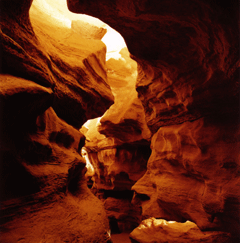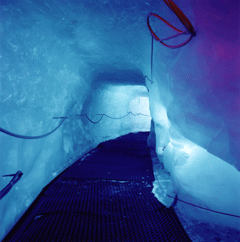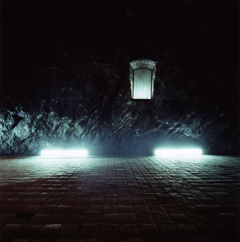Exhibition information
Lucinda Devlin
Subterranea
Subterranea
Lucinda Devlin’s (*1947 in Ann Arbor, Michigan) series Subterranea, which will be on view for the first time at Galerie m Bochum from 30 January to 29 March 2008, takes us into the underground world of caves and glaciers that bear the traces of human intervention.
Lucinda Devlin has traversed the continents for over 20 years now to photograph hidden subterranean caverns. The resulting series, which she first compiled in 2006, includes photos of radon galleries with purported healing powers in Germany, American caves that have been turned into tourist attractions, the “Salt Cathedral” in Colombia, a glacier atop the Matterhorn in Switzerland et al.
As in her other series (e.g. The Omega Suites, Corporal Arenas), Devlin has chosen places of significance to cultural history, but shows them absent their usual human occupants. The signs of man’s presence are all around, however, in the form of handrails, floor mats, wastebaskets, light bulbs and lounge chairs. Her pictures thus depart considerably from the glossy photos made to attract potential cave visitors and spa guests. The photographer’s characteristic cool and distanced gaze points up the absurdity and bizarreness of these human interventions imposed upon nature like alien bodies. At the same time, it must be admitted that civilization has, quite literally, brought light into the darkness, both revealing the beauty of the rock formations and creating fascinating light effects, which sometimes have an “above-ground” feeling. The way Devlin captures how the caves are illuminated, with stark contrasts between dark and light, is one of the elements that makes for the special appeal of Subterranea.
The intensity of these photographs lies in the independence of the individual images from their narrative content. The viewer can read the images or simply enjoy them from a purely aesthetic point of view. Not just conveyors of meaning and content, these photos have a strong pictorial presence that evokes an immediate sensory response.
Lucinda Devlin has traversed the continents for over 20 years now to photograph hidden subterranean caverns. The resulting series, which she first compiled in 2006, includes photos of radon galleries with purported healing powers in Germany, American caves that have been turned into tourist attractions, the “Salt Cathedral” in Colombia, a glacier atop the Matterhorn in Switzerland et al.
As in her other series (e.g. The Omega Suites, Corporal Arenas), Devlin has chosen places of significance to cultural history, but shows them absent their usual human occupants. The signs of man’s presence are all around, however, in the form of handrails, floor mats, wastebaskets, light bulbs and lounge chairs. Her pictures thus depart considerably from the glossy photos made to attract potential cave visitors and spa guests. The photographer’s characteristic cool and distanced gaze points up the absurdity and bizarreness of these human interventions imposed upon nature like alien bodies. At the same time, it must be admitted that civilization has, quite literally, brought light into the darkness, both revealing the beauty of the rock formations and creating fascinating light effects, which sometimes have an “above-ground” feeling. The way Devlin captures how the caves are illuminated, with stark contrasts between dark and light, is one of the elements that makes for the special appeal of Subterranea.
The intensity of these photographs lies in the independence of the individual images from their narrative content. The viewer can read the images or simply enjoy them from a purely aesthetic point of view. Not just conveyors of meaning and content, these photos have a strong pictorial presence that evokes an immediate sensory response.


Glacier Paradise at the Matterhorn #3
Zermatt, Switzerland 2007
Zermatt, Switzerland 2007

Salt Cathedral #2
Zipaquirá, Colombia 1985
Zipaquirá, Colombia 1985
